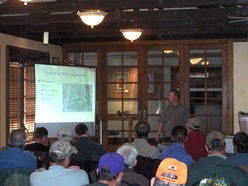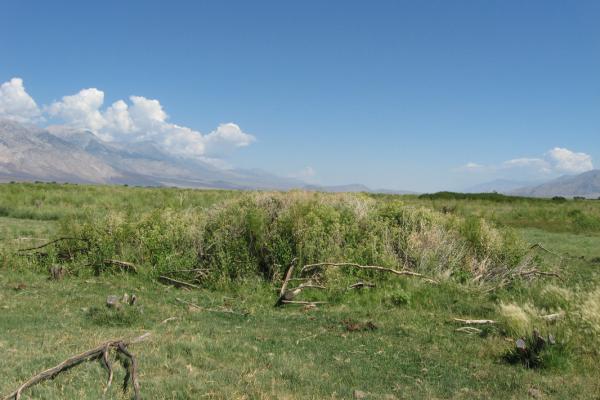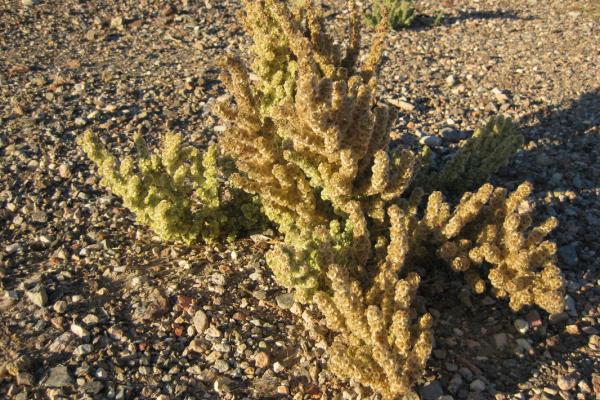Eastern Sierra Weed Management Area
ESWMA Mission Statement:
To facilitate, coordinate and promote the establishment of an integrated weed management program directed toward the eradication and control of noxious weeds in the Eastern Sierra Weeds Management Area (ESWMA). Boundaries of the management area extend south to Nine Mile Canyon (Kennedy Meadows Road), east to Owens Lake, north to include the crest if the Inyo and White Mountains, the California/Nevada border to Bridgeport, then west to include the crest of the Sierra Nevada Mountains down to Nine Mile Canyon. Although, the ESWMA working group feels these are manageable boundaries, they also remain flexible so that is a noxious weed population requires treatment outside these boundaries and the group agrees this is a priority project, then the project will be considered.
What is and exotic species? There are invasive weeds that present a serious threat to lands in Inyo and Mono Counties. Weeds take over native environments and cause many problems, such as increased erosion fire danger and water consumption, decreased wildlife habitat and biodiversity, and losses in recreational opportunities and crop destruction. Some weedy species are even toxic to livestock and humans.
Members The Eastern Sierra Weed Management Area was officially formed in 1998 and was entered into by the California Department of Food and Agriculture, Inyo/Mono Counties' Agricultural Commissioner's Office, Los Angeles Department of Water and Power, Inyo County Water Department, Bureau of Land Management Bishop Field Office, Inyo National Forest, Toiyabe National Forest, California Department of Forestry, Natural Resource Conservation Service, Inyo/Mono Conservation District, Inyo/Mono Counties' Cattleman's Association, and the California Department of Transportation District 9. Later, the Bishop Paiute Tribe Environmental Office, California State Parks, and BLM California Desert District joined.
 The Inyo/Mono Counties’ Agricultural Commissioner’s office operates a noxious weed program as well as administering the Eastern Sierra Weed Management Area. The ESWMA includes public and private entities that aid in local weed issues. In 2011, this program was responsible for controlling about 153.54 net acres of weeds that covered over 70,990 gross acres of range and cropland. The weed program is also involved with controlling and preventing weed spread in the newly re-watered LORP area.
The Inyo/Mono Counties’ Agricultural Commissioner’s office operates a noxious weed program as well as administering the Eastern Sierra Weed Management Area. The ESWMA includes public and private entities that aid in local weed issues. In 2011, this program was responsible for controlling about 153.54 net acres of weeds that covered over 70,990 gross acres of range and cropland. The weed program is also involved with controlling and preventing weed spread in the newly re-watered LORP area.
Some of the serious weedy invaders that occur locally include Perennial pepperweed, Dalmatian toadflax, Halogeton, Russian knapweed, Spotted knapweed, Canada thistle and Scotch thistle (see photos below). All of these weeds have the potential to spread explosively. Perennial pepperweed has taken over other areas in the Eastern Sierra, such as Reno, NV and Susanville, CA, where there is no longer hope that it can be controlled. Russian knapweed, Spotted thistle, and Canada thistle have taken over many rangeland areas in the western US and destroyed the environment and agricultural usability of the land. Scotch thistle has created dense stands in many parts of northern California that not even cattle can walk through. If invasive weed threats are not taken seriously, these scenarios could be repeated here in Inyo and Mono Counties.
Public education and outreach is an import ant component of a comprehensive management plan. Staff have presented information to area residents during several area meetings including pesticide education safety seminars, a California Garden Clubs Meeting, Bernasconi Center Workshops for 6th grade camp, California Native Plant Society Meetings, and Inyo County Board of Supervisors Workshops. Public service messages related to weeds are placed in the local fishing guide and in two local newspapers throughout the year. In addition to these outreach methods, our program provides literature related to weeds at several area sporting goods stores, the Tri-County Fair, and at the Agricultural Commissioner and local Forest Service offices.
ant component of a comprehensive management plan. Staff have presented information to area residents during several area meetings including pesticide education safety seminars, a California Garden Clubs Meeting, Bernasconi Center Workshops for 6th grade camp, California Native Plant Society Meetings, and Inyo County Board of Supervisors Workshops. Public service messages related to weeds are placed in the local fishing guide and in two local newspapers throughout the year. In addition to these outreach methods, our program provides literature related to weeds at several area sporting goods stores, the Tri-County Fair, and at the Agricultural Commissioner and local Forest Service offices.
 The Inyo and Mono Counties Agricultural Commissioner’s Office (AgComm) is the administrative member of the Eastern Sierra Weed Management Area (ESWMA) group. Interaction between members of this group promotes cooperation with weed management projects and activities. Viewing invasive plant issues without the lens of jurisdictional or other boundaries helps managers see the issue of these weeds as it truly is - a regional or watershed issue. ESWMA coordinates and communicates with bordering weed management groups for this reason. Several regional land management meetings were attended by representatives of ESWMA to maintain communications with other groups, and to ensure invasive plant issues are represented in discussions on such matters.
The Inyo and Mono Counties Agricultural Commissioner’s Office (AgComm) is the administrative member of the Eastern Sierra Weed Management Area (ESWMA) group. Interaction between members of this group promotes cooperation with weed management projects and activities. Viewing invasive plant issues without the lens of jurisdictional or other boundaries helps managers see the issue of these weeds as it truly is - a regional or watershed issue. ESWMA coordinates and communicates with bordering weed management groups for this reason. Several regional land management meetings were attended by representatives of ESWMA to maintain communications with other groups, and to ensure invasive plant issues are represented in discussions on such matters.
 AgComm uses several methods of detection and control to manage invasive plants. Integrated Pest Management (IPM) is the focus of these efforts, and AgComm attempts to employ the best possible alternative for treatment considering the specific situation and target species. Methods for detection include exclusion activities such as nursery inspections, public outreach, roadside surveys, surveys of agricultural lands, and surveys of areas used heavily for recreation. Weed removal and eradication methods encompass mechanical, chemical and biological control, and cultural practices that discourage weed colonization and spread. Once weeds have been removed from an area surveys must continue for at least five years to establish full eradication of the population, as many weedy species have seeds that are viable for many years.
AgComm uses several methods of detection and control to manage invasive plants. Integrated Pest Management (IPM) is the focus of these efforts, and AgComm attempts to employ the best possible alternative for treatment considering the specific situation and target species. Methods for detection include exclusion activities such as nursery inspections, public outreach, roadside surveys, surveys of agricultural lands, and surveys of areas used heavily for recreation. Weed removal and eradication methods encompass mechanical, chemical and biological control, and cultural practices that discourage weed colonization and spread. Once weeds have been removed from an area surveys must continue for at least five years to establish full eradication of the population, as many weedy species have seeds that are viable for many years.
Preventing weed establishment is the easiest and most cost effective form of weed control. Inspection and survey of potential sources of weed introduction is an important part of AgComm’s weed management strategy. Staff from the weed management program survey areas of high recreational use for weeds regularly, especially those attracting users from other regions, states, or countries. Program staff also conducts inspections of plant shipments and surveys of highway roadsides frequently to detect any weed introduction promptly. Agricultural land surveys identify weed infestations early and prevent spread to new areas when agricultural commodities are harvested and distributed. Public outreach is an important component in weed prevention and detection, and AgComm staff distributes weed identification booklets to interested parties, present information at local gatherings such as the annual pesticide safety seminar and the local 6th grade camp, and create other educational outreach material such as press releases and posters.
 Our weed program employs several different methods to remove weeds when they are discovered. Mechanical control, such as hand-pulling weeds, is used where this technique is feasible and effective. Chemical control via low volume application of appropriate approved herbicides is used where infestation sizes are too large to allow for the effective use of other methods. Biological controls, such as seed eating weevils or foliage destroying beetles, are used on plants that are susceptible to this method of control. Through education and outreach efforts, AgComm staff attempts to encourage positive changes in cultural practices that will help to prevent weed establishment and spread. An example of cultural practice modification is lessening soil disturbance related to agricultural production to avoid weed colonization around fields.
Our weed program employs several different methods to remove weeds when they are discovered. Mechanical control, such as hand-pulling weeds, is used where this technique is feasible and effective. Chemical control via low volume application of appropriate approved herbicides is used where infestation sizes are too large to allow for the effective use of other methods. Biological controls, such as seed eating weevils or foliage destroying beetles, are used on plants that are susceptible to this method of control. Through education and outreach efforts, AgComm staff attempts to encourage positive changes in cultural practices that will help to prevent weed establishment and spread. An example of cultural practice modification is lessening soil disturbance related to agricultural production to avoid weed colonization around fields.
After removing weeds from a location staff revisits sites for at least five years to ensure re-growth does not occur. After this five year period the infestation can be declared eradicated. Depending on the long-term viability of the seeds belonging to the target species, site revisits may continue longer than five years. During surveys, nearby areas with potential for colonization are also examined, such fields irrigated from ditches linked to the infested site, or roadsides connected to infested areas.








